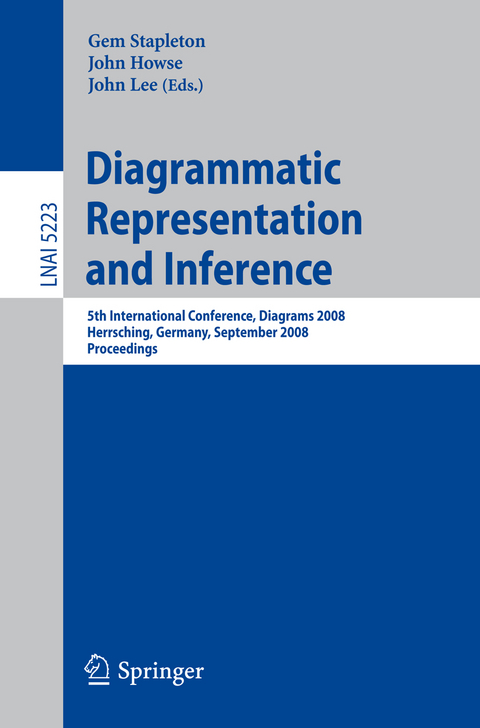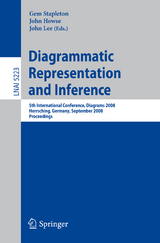Diagrammatic Representation and Inference
Springer Berlin (Verlag)
978-3-540-87729-5 (ISBN)
Keynote Reflections.- Heterogeneous Reasoning.- Rich Data Representation: Sophisticated Visual Techniques for Ease and Clarity.- Model Driven Development with Mechatronic UML.- Tutorials.- Cognitive Dimensions of Notations: Understanding the Ergonomics of Diagram Use.- Getting Started with Sketch Tools.- Diagram Aesthetics and Layout.- General Euler Diagram Generation.- Euler Diagram Decomposition.- Smooth Linear Approximation of Non-overlap Constraints.- Extremes Are Better: Investigating Mental Map Preservation in Dynamic Graphs.- Psychological and Cognitive Issues.- An Eye-Tracking Study of Exploitations of Spatial Constraints in Diagrammatic Reasoning.- What Diagrams Reveal about Representations in Linear Reasoning, and How They Help.- What Can Pictorial Representations Reveal about the Cognitive Characteristics of Autism?.- Visual Thinking with an Interactive Diagram.- Applications of Diagrams.- Strategy Roadmaps: New Forms, New Practices.- VAST Improvements to Diagrammatic Scheduling Using Representational Epistemic Interface Design.- Enhancing State-Space Tree Diagrams for Collaborative Problem Solving.- Visual Programming with Interaction Nets.- Theoretical Aspects.- Spider Diagrams of Order and a Hierarchy of Star-Free Regular Languages.- Diagrammatic Reasoning System with Euler Circles: Theory and Experiment Design.- A Normal Form for Euler Diagrams with Shading.- Ensuring Generality in Euclid's Diagrammatic Arguments.- Depicting Negation in Diagrammatic Logic: Legacy and Prospects.- Diagrams in Education.- Transforming Descriptions and Diagrams to Sketches in Information System Design.- Graphical Revelations: Comparing Students' Translation Errors in Graphics and Logic.- Learning from Animated Diagrams: How Are Mental Models Built?.- Diagrams for theMasses: Raising Public Awareness - From Neurath to Gapminder and Google Earth.- Understanding and Comprehension.- Detection of Sample Differences from Dot Plot Displays.- Visualizing Non-subordination and Multidominance in Tree Diagrams: Testing Five Syntax Tree Variants.- The Effects of Users' Background Diagram Knowledge and Task Characteristics upon Information Display Selection.- Multimodal Comprehension of Graphics with Textual Annotations: The Role of Graphical Means Relating Annotations and Graph Lines.- Posters.- Talk to the Hand: An Agenda for Further Research on Tactile Graphics.- Openproof - A Flexible Framework for Heterogeneous Reasoning.- Cognitive and Semantic Perspectives of Token Representation in Diagrams.- Estimating Effort for Trend Messages in Grouped Bar Charts.- Types and Programs from Euler Diagrams.- Diagrams in the UK National School Curriculum.- LePUS3: An Object-Oriented Design Description Language.- Utilizing Feature Diagrams to Assess the Capabilities of Tools That Support the Model Driven Architecture.- Diagrammatic Knowledge-Based Tools for Complex Multi-dynamic Processes.- Supporting Reasoning and Problem-Solving in Mathematical Generalisation with Dependency Graphs.- A Concept Mapping Tool for Nursing Education.- Cognitive Methods for Visualizing Space, Time, and Agents.- Benefits of Constrained Interactivity in Using a Three-Dimensional Diagram.- A Strategy for Drawing a Conceptual Neighborhood Diagram Schematically.- Supporting Relational Processing in Complex Animated Diagrams.- Animated Cladograms: Interpreting Evolution from Diagrams.- Automatic Diagram Drawing Based on Natural Language Text Understanding.- Texts and Graphs Elaboration: The Effect of Graphs' Examination on Recall.- Diagrammatic Logic of Existential Graphs: ACase Study of Commands.- Diagrammatic Reasoning in Separation Logic.- Method of Minimal Representation: An Alternative Diagrammatic Technique to Test the Validity of Categorical Syllogisms.- The Relationship between Graph Comprehension and Spatial Imagery: Support for an Integrative Theory of Graph Cognition.- Using MusicXML to Evaluate Accuracy of OMR Systems.- Aestheticization of Flowcharts.- Towards Diagrammatic Patterns.- Visualizing Meaning: Literacy Materials for Dyslexic Children.- Diagrammatic Interrelationships between Global and Local Algebraic Visual Objects: Communicating the Visual Abstraction.- School Curriculum Development to Promote Student Spontaneous Diagram Use in Problem Solving.
| Erscheint lt. Verlag | 10.9.2008 |
|---|---|
| Reihe/Serie | Lecture Notes in Artificial Intelligence | Lecture Notes in Computer Science |
| Zusatzinfo | XV, 445 p. |
| Verlagsort | Berlin |
| Sprache | englisch |
| Maße | 155 x 235 mm |
| Gewicht | 706 g |
| Themenwelt | Informatik ► Theorie / Studium ► Künstliche Intelligenz / Robotik |
| Schlagworte | aes • Agents • animated diagrams • bivalence • Cognition • Complementation • complex processes • Concept Map • conceptual modeling • Design • Diagrammatic Communication • diagrammatic logic • Diagrammatic Reasoning • Diagrams • Diagram Semantics • Diagram Syntax • dichotomy • Ergonomics • Evolution • Eye-Tracking • feature diagrams • First-Order Logic • flowcharts • graph comprehension • Graphical Representation • Hardcover, Softcover / Informatik, EDV/Informatik • HCI • HC/Informatik, EDV/Informatik • Information Visualization • Intelligent Agents • Knowledge • Knowledge Acquisition • learning • Medical Visualization • mental representations • Multi-modality • natural language • optical music recognition • pattern recognition • perceptual processing • Probabilistic Reasoning • Process Modeling • public awareness • Spatial Cognition • Statistical Graphics • text-graphics comprehension • theoretical framework • topological diagrams • tree diagrams • Usability • Visualization • Visual Languages • visual programming • visual reasoning • Visual Representation |
| ISBN-10 | 3-540-87729-0 / 3540877290 |
| ISBN-13 | 978-3-540-87729-5 / 9783540877295 |
| Zustand | Neuware |
| Haben Sie eine Frage zum Produkt? |
aus dem Bereich




